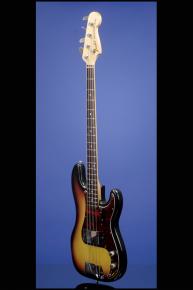Late Sixties "Under The Bed"
Fender Precision Bass
This 13-inch-wide bass guitar weighs just 8.90 lbs. and has a nice comfortable nut width of 1 5/8 inches and a full bass scale length of 34 inches. Solid alder body contoured on back and lower bass bout, one-piece maple neck with a medium to thick profile, and veneer rosewood fretboard with 20 frets and pearloid dot position markers. Single circular string tree. Fender cloverleaf tuners without "trademark". Headstock decal with Fender logo in black with gold trim, "Precision Bass" in black beside it, and four patent number beneath it. Four-bolt neckplate with the large "F" logo and serial number ("279459") between the top two screws. One split black eight-polepiece pickup (stamped underneath "0082" and "1182"). Four-layer (tortoiseshell/white/black/white) plastic pickguard with thirteen screws. Two controls (one volume and one tone) on lower treble bout. Knurled chrome knobs with flat tops. Combined four-saddle bridge/tailpiece and both the original bridge and pickup covers. The end of the neck is stamped "5 23 232 B" the underside of the neck is stamped "J. Torres," the neck pocket is stamped "A. Murillo" and "Frank Ayala," and the pots are stamped "304 7023" (Stackpole June 1970). This guitar is in mint (9.50) condition and is complete with the original black leather guitar strap, original Fender hang tag/warranty with matching serial number, original Fender polishing cloth in plastic bag (unopened), original Fender plastic case tag and original case key. Housed in the original Fender black hardshell case with reddish orange plush lining (9.50).
The Precision Bass, with its revolutionary new shape, was launched in 1951, and originally had a slab body. It was not until 1954, with the introduction of the Stratocaster, that Fender contoured the body. All early Precision Basses had one-piece maple necks, but in 1959, a slab-board rosewood fretboard was introduced. Many players missed the comfort of the maple fretboard, so from around 1967 to 1969, a one-piece maple neck was offered as an option. Our guitar has an extremely rare maple-cap neck and fretboard, which was obviously specially ordered at the time. We know that maple-cap Telecasters were available to special order from around 1966, but we have never seen or heard of another 1965 maple-cap Precision Bass.
Until the Precision, the bass was an upright acoustic instrument that was difficult to hear and cumbersome to transport. Leo Fender's invention allowed musicians to hold their instrument like a guitar, opening the bass world to curious guitar players, and allowing bass players a level of freedom they had not yet encountered. Due to the bass's solid body construction, it could be amplified to any level, giving it new found aural presence. In its first fifteen years of development, the Precision Bass changed as much as the music it influenced and the musicians it inspired, having been played by everyone from The Shadows to Led Zeppelin.
Translate:













